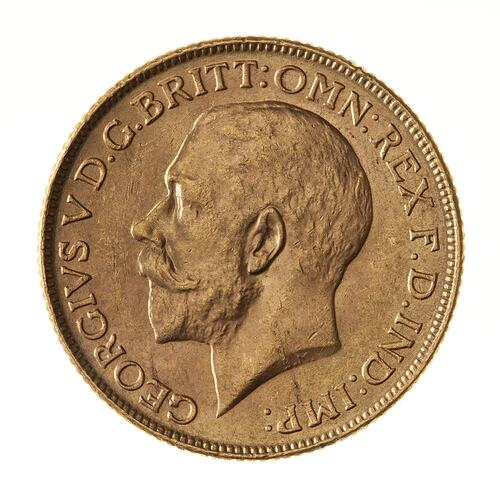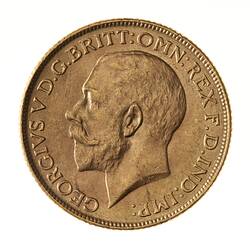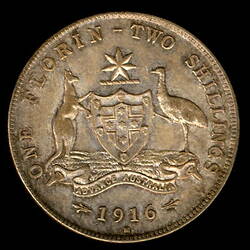Summary
Sovereign, Issued by India, 1918 I
Minted by Bombay Branch of the Royal Mint
Obverse Description
Head of George V facing left; around, GEORGIVS V D.G. BRITT: OMN: REX F:D: IND: IMP:
Reverse Description
Equestrian figure of St. George attacking a dragon with a sword; below, 1918 and the tiny letter I at the middle of the ground line
Edge Description
Milled
Significance
Indian gold coin was not legal tender. In 1864 the Indian government authorised the acceptance of Imperial sovereigns and half-sovereigns in payments to the Treasury at the rate of 10 and 5 rupees respectively but the coins were not made legal tender. In 1868 sovereigns and half-sovereigns minted in Sydney were added to the Imperial issues as acceptable in payment to Treasury. From 1871 Sydney produced Imperial types (both St. George and Shield reverses) as did the new mint at Melbourne from 1872. From the 1870s there was an expectation that the mohur coinage would be replaced by sovereigns, to the extent that coining mohurs ceased for a time from 1891. In 1899, the year that the Perth Branch of the Royal mint began production of sovereigns, Imperial gold sovereigns were declared legal tender along side the silver rupee and it was decided that a mint would be established in Bombay to strike sovereigns. For a mint outside Britain to produce the sovereign it had to be a Branch of the Royal Mint. Building work on the new mint was begun but the concept was abandoned in 1903. World War I however brought about a crisis in availability of silver and copper which saw India move to a greater reliance on paper money. The issues of paper were backed by gold bullion and a variety of gold coin. To simplify matters it was decided that this gold should be coined into sovereigns. An area of the Bombay mint was set aside and isolated from other mint activities and was proclaimed a branch of the Royal Mint. Dies were provided for sovereigns from London (as was the case for all branch mints) and production began on 15 August 1918. The coins are distinguished by the mint mark I at the centre of the ground below St. George. 1,296,033 sovereigns were struck but there was no further call for gold coinage and the branch was closed in April 1919.
More Information
-
Collecting Areas
-
Acquisition Information
Purchase from Spink (Australia), 14 Jul 1993
-
Date Issued
1918 AD
-
Issued By
-
Mint
-
Artist
-
Artist
-
Denomination
-
Series
-
Material
Gold
-
Axis
12
-
Classification
-
Category
-
Discipline
-
Type of item
-
Dimensions
22 mm (Outside Diameter), 7.982 g (Weight)
-
Shape
Round
-
References
Pridmore 27 KM#525A
[Book] Pridmore, Fred. 1980. The Coins of the British Commonwealth of Nations, Part 4, India. 2., 105 Pages
[Book] Bruce, Colin R. 2009. 2009 Standard Catalogue of World Coins 1901 - 2000., 1100 Pages
-
Keywords
British Commonwealth Coins, British Commonwealth and Empire Coins




